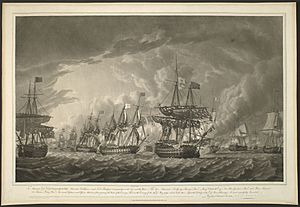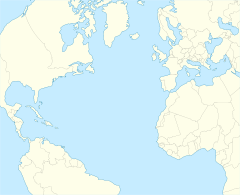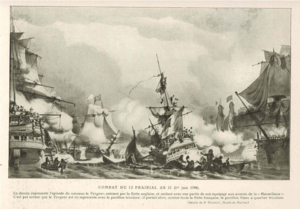Atlantic campaign of May 1794 facts for kids
Quick facts for kids Atlantic campaign of May 1794 |
|||||||
|---|---|---|---|---|---|---|---|
| Part of the naval operations during the War of the First Coalition | |||||||
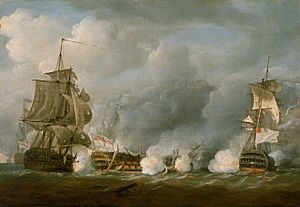 HMS Defence at the Battle of the Glorious 1st June 1794, Nicholas Pocock |
|||||||
|
|||||||
| Belligerents | |||||||
| Commanders and leaders | |||||||
The Atlantic campaign of May 1794 was a series of naval operations. It involved the British Royal Navy's Channel Fleet and the French Navy's Atlantic Fleet. The main goal for the British was to stop a very important French grain convoy. This convoy was traveling from the United States to France.
The campaign included smaller attacks on merchant ships. It also had two minor battles. Finally, it ended with a huge fleet battle known as the Glorious First of June in 1794. Both sides suffered heavy damage. Britain and France each claimed victory. France lost seven large warships called ships of the line. Britain lost none. However, the battle kept the British fleet busy. This allowed the French convoy to reach port safely.
By spring 1794, France was at war with its neighbors. The French government faced severe food shortages. They needed grain from their colonies and the United States. This food was to be shipped across the Atlantic Ocean in April, May, and June. A small group of warships would protect it. A larger group would support them in the Bay of Biscay.
However, political problems had weakened the French Navy. They also lacked supplies and had low morale. The British Navy, on the other hand, was well-prepared. But it had a shortage of trained sailors.
The French Atlantic Fleet, led by Admiral Villaret de Joyeuse, had a key job. It needed to keep the British Channel Fleet busy. This would give the grain convoy time to reach France. The British Channel Fleet, led by Lord Howe, knew about the convoy. Howe sent smaller groups of ships to protect British trade. He then chased Villaret with his main fleet.
For over a week, the two fleets moved around each other. Villaret pulled Howe deeper into the Atlantic. This moved Howe further away from the convoy. Two smaller battles happened on May 28 and 29. During these, Howe gained the "weather gage." This meant he could choose when and where to attack next.
The biggest battle of the campaign happened over 740 kilometers (400 nautical miles) into the Atlantic. It became known as the Glorious First of June. Howe used his advantage to attack Villaret directly. Villaret tried to fight in a traditional line formation. The British fleet won a major victory after a tough day of fighting. Howe forced Villaret to retreat. His forces captured seven French battleships. One of these later sank. The French suffered about 7,000 casualties. However, Villaret said he won a strategic victory. His delaying tactics had given the convoy enough time to reach France safely. This battle was one of many defeats for the French Navy early in the war. It made French officers less willing to fight the British at sea.
Contents
Why the Campaign Happened
In the winter of 1793, France faced serious problems. War, internal unrest, and bad weather led to food shortages. France was fighting its neighbors, so it could not get food by land. The only country willing to sell grain was the United States.
Bringing food from America was very risky. The British Royal Navy had been at war with France since early 1793. They patrolled much of the Atlantic. To protect the food ships, France and the United States made a plan. They would gather supplies over several months. Then, they would ship them all together in one large convoy. The meeting point was Hampton Roads in the Chesapeake Bay.
Protecting the Convoy
Admiral Pierre Vanstabel led a group of ships to Hampton Roads. His job was to escort the convoy to the Bay of Biscay. There, a second group of ships, led by Joseph-Marie Nielly, would join him. Together, they had six large warships and many smaller ones.
The main French battle fleet had 25 ships. Admiral Villaret de Joyeuse commanded it. His job was to patrol the Bay of Biscay. He would challenge the British Channel Fleet if they tried to stop the food ships. The convoy was expected to take about two months. It had 117 merchant ships. These ships carried enough food to feed France for a year.
Lord Howe, the British Channel Fleet admiral, knew about the convoy. He knew where it was going long before it left America. He made plans to block its path. He sent small groups of ships to protect British trade. Admiral George Montagu took six battleships to search for the convoy in the southern Bay. Howe took his main fleet of 26 ships to patrol near Brest.
May 1794: The Chase Begins
April 1794 was a busy month for both sides. Villaret and Howe got ready for the campaign. The slow French convoy left America on April 2. British convoys left Portsmouth on May 2. Howe used his whole fleet to protect them. He sent two fast ships, HMS Latona and HMS Phaeton, to check on the French fleet at Brest. They reported that Villaret's fleet was still in port.
Attacks on Merchant Ships
Out in the Atlantic, Nielly's French ships and Montagu's British ships were attacking enemy merchant ships. This is called commerce raiding. But they had not yet found the main food convoy. Nielly found a British convoy from Newfoundland. He captured ten ships, including their escort, the 32-gun frigate HMS Castor. Captain Thomas Troubridge of the Castor stayed on Nielly's flagship, Sans Pareil.
Montagu also had success on May 15. He recaptured the merchant ships Nielly had taken. He also captured a French ship and got important information. This information was about the French convoy's location and size. Montagu immediately sent it to Howe. Nielly then found the convoy from America a few days later. He added two of his ships to the convoy's escort. He then went back to the Eastern Atlantic. He looked for British ships that might threaten the convoy. He also sent fast ships to Villaret with convoy information.
While Nielly and Montagu were at sea, Howe cruised the Bay of Biscay. He hoped to catch the convoy. From May 5 to May 18, he found nothing. He returned to Brest. His scouting ships reported that the French battle fleet had left. Villaret had sailed the day before, hidden by thick fog. His ships passed close to the British fleet. The French admiral was looking for Nielly's squadron. He wanted to meet Nielly and the convoy. With more ships, he could then escort the convoy safely to France. Villaret avoided Howe and then found a Dutch convoy of 53 ships. Its escorts ran away. Villaret captured 20 merchant ships.
Howe Chases Villaret
Howe realized that Villaret's path would cross Montagu's route. If Montagu met Villaret, his squadron would be destroyed. Howe set all sails and chased Villaret into the Atlantic on May 20. The next day, Howe's ships recaptured ten of the Dutch merchant ships. But he had to burn them. He did not have enough British sailors to crew them. Prisoners from these ships told Howe that the French fleet was close ahead. They also said it had gained more ships from Nielly's squadron. Howe was now sure Montagu was safe. He pushed on, hoping to fight Villaret within a week.
On May 23, strong winds pushed the British fleet south. They had to slowly sail north again to find the French. This detour allowed Howe to recapture and destroy four more of Villaret's Dutch prizes.
On May 25, Howe's chase finally paid off. His scouting ships spotted a single French warship at 4:00 AM. This ship saw Howe's fleet at the same time. It immediately sailed towards the French fleet. The fleeing warship left behind an American merchant ship it was towing. When captured, the American ship reported that the French ship was Audacieux, from Nielly's squadron. Howe chased Audacieux after burning the American prize. The British fleet also caught and burned two French smaller warships. These were the 20-gun Républicaine and 16-gun Inconnue. Howe continued his chase for the next three days. On May 28, Howe's lookouts saw the French to the east and slightly south. This meant the French had the "weather gage." This was an advantage, allowing them to control the battle.
May 28: First Clashes
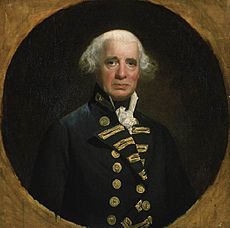
By 6:30 AM, Howe could see the enemy from his flagship. He called back his fast ships and ordered his fleet to sail quickly. He hoped to attack the back of the spread-out French line. By 10:35 AM, Howe's chase made his own battle line messy. But he kept going. He believed Villaret planned to use the weather gage to outrun him. To stop this, Howe ordered his fastest ships into a special group. Admiral Thomas Pasley led this "flying squadron." These ships were much faster than most ships in either fleet. They quickly closed in on the French rear.
The first shots were fired at 2:30 PM by HMS Russell. Captain John Willett Payne commanded it. It fired long-distance shots at the last French ships. The French fired back, but without much effect. To hold off Pasley's squadron, the large French 110-gun ship Révolutionnaire moved to the back of the line at 5:00 PM. It fought the British ships chasing them.
At 6:00 PM, HMS Bellerophon, a slower British ship, managed to fight Révolutionnaire. They exchanged fire for twenty minutes. The weaker Bellerophon was badly damaged. It fell back. HMS Marlborough took its place. HMS Russell and HMS Thunderer joined Marlborough. Together, they shot away much of Révolutionnaire's rigging. By 7:30 PM, the French ship could not be steered. HMS Leviathan also joined the fight.
Howe worried about Pasley's squadron getting cut off. He called them back to the British line at 8:00 PM. All ships obeyed except HMS Audacious. Captain William Parker commanded it. Audacious was fighting Révolutionnaire too closely to leave safely. Its guns eventually destroyed the huge French ship's masts. But Audacious also took heavy damage.
It was 10:00 PM before Audacious and Révolutionnaire separated. Their fleets were now some distance away. Audacious's crew later said Révolutionnaire surrendered. But this was not confirmed. Parker said he did not capture Révolutionnaire because he saw nine French battleships in the distance. These were ships from another French group, not involved in this campaign. They soon disappeared. Audacious's crew worked hard to repair their ship. They tried to rejoin the British fleet during the night. But they got lost. In the morning, Audacious was still close to Révolutionnaire.
Révolutionnaire was much more damaged than Audacious. But it was not captured. This was because Captain Albemarle Bertie of Thunderer misunderstood a signal. He failed to capture the dismasted French ship when ordered. During the night, Villaret sent ships to rescue Révolutionnaire. At dawn on May 29, Parker saw that Audacieux, the frigate Bellone, and two smaller ships were coming to help Révolutionnaire. Audacious again came under fire from Révolutionnaire. It had no choice but to escape this stronger force. Audacious was chased for half an hour. Then it lost them in a rainstorm. It finally returned to Plymouth on June 3. Révolutionnaire also escaped. Audacieux towed it safely to Rochefort days later. The captain of Révolutionnaire was later arrested for leaving the battle fleet.
May 29: A Confused Battle
Audacious and Révolutionnaire were lost in the dark behind them. Both British and French fleets kept sailing west. They were heading towards the convoy's meeting point. At dawn on May 29, the British fleet saw Audacieux leaving to the east. But they did not follow. They focused on the main French line. They hoped to start a decisive battle.
Howe ordered his ships to chase the enemy's rear. The British line was set to cut through the French line. This would isolate and capture the ships east of the cut. Captain Anthony Molloy in HMS Caesar was chosen to lead. His ship was the fastest. But the plan failed completely. Molloy strangely refused to get close to the enemy. Instead, Caesar and HMS Queen fired at the last French ships from a distance. The front parts of both fleets then fought a long-range gun duel from 10:00 AM. This caused minor damage to both sides. The French ship Montagnard was hit the worst.
Howe had failed to cut the French line the first time. He gave the order again at 12:30 PM. Again, Caesar was to lead. The goal was to split the enemy fleet in half. But Captain Molloy again refused. He signaled that Caesar could not turn. Then he sailed east, away from the enemy. This unexpected move confused the ships following him. Queen, behind Caesar, tried to obey Howe's signal alone. It was badly damaged by cannon fire. Its captain, John Hutt, was fatally wounded. Queen could not move well. It sailed down the outside of the French line, firing as it went.
Howe's plan was ruined. He responded by leading his flagship, HMS Queen Charlotte. He steered it towards the French line, which was moving ahead. He went around the wandering Caesar. Queen Charlotte first tried to break through the French line between the sixth and seventh ships from the rear. But it could not reach this gap. Instead, it sailed between the fifth and sixth ships. It fired into the side of the sixth ship, Éole, from close range. Bellerophon and Lord Hugh Seymour in Leviathan followed close behind. Both tried to cut between the next French ships. Bellerophon succeeded. Leviathan could not because of damage to its steering. This move changed the battle. Howe's ships isolated and attacked Terrible, Tyrannicide, and Indomptable. This forced Villaret to either abandon his ships or lose the weather gage to save them.
Howe chased the main French fleet. The damaged Terrible followed behind. The rest of Howe's fleet followed, firing at the already damaged Tyrannicide and Indomptable. As HMS Orion, HMS Invincible, and HMS Barfleur cut through the French line, Villaret turned his fleet to face Howe. He was encouraged by Caesar's disobedience. He purposely gave up the weather gage. He believed Howe's fleet was more damaged than it looked. All of Villaret's ships followed him except Montagnard. It refused to turn, claiming to be badly damaged.
Villaret's move soon isolated Queen Charlotte, Bellerophon, and Leviathan. They had to quickly retreat from the main French force. After driving away the ships threatening Indomptable and Tyrannicide, Villaret reformed his fleet. He tried to escape west. The British front ships, now holding the weather gage, followed closely. Both fleets were too damaged to keep fighting in the remaining daylight. Firing stopped at 5:00 PM. The British fleet had 67 killed and 128 wounded that day.
That evening, the fleets were about 18 kilometers (10 nautical miles) apart. They were sailing northwest. Both sides were making quick repairs. They were getting ready for another battle on May 30. Lord Howe did not know that the slow convoy of merchant ships was passing to the northeast. It had successfully avoided the British. Villaret knew where the convoy was. The damaged Montagnard joined it that evening. Admiral Nielly, escorting the convoy, learned about the situation from Montagnard's captain. He left his escort duties to help Villaret.
After the day's action, the British frigate Castor was attacked. It had been captured by Nielly earlier in the campaign. The smaller HMS Carysfort under Captain Francis Laforey recaptured it. Some of the crew were freed. But most, including the officers, were not on board. They had been taken onto Nielly's flagship, Sans Pareil.
Between the Battles
On the morning of May 30, Howe asked his captains if their ships were ready for combat. All but Caesar said yes. Howe pushed his ships after the retreating French. Howe had the weather gage, but thick fog slowed his chase. He could not see or reach the enemy all day. The admiral feared he had lost his chance for battle.
However, by May 31, the fog had cleared. The French were still in sight to the north. The British were surprised. None of the 26 French battleships seemed to show battle damage. Many British ships had damaged rigging and hulls. Villaret had used the fog to reorganize his force. He lost Montagnard and the frigate Seine to the convoy. But he gained the battleship Trente-un-Mai and Nielly's squadron. This squadron included Sans Pareil, Trajan, and Téméraire. Villaret had also sent the damaged Indomptable home, escorted by an undamaged French ship.
Throughout May 31, Howe's fleet closed in on the French. They used their weather gage advantage. By 5:00 PM, the fleets were 9 kilometers (5 miles) apart. But at 7:00 PM, Howe ordered his ships to stay out of firing range. He wanted to be sure of a full day for battle. He did not want a repeat of the confusion on May 29. He wanted his signals to be clear. During the night, the fleets stayed in sight. By first light on June 1, the British were just 11 kilometers (6 miles) from Villaret's fleet. They were getting ready to attack again. Both fleets were sailing west. Villaret still hoped to draw Howe away from the convoy.
Glorious First of June: The Big Battle
At 9:24 AM on June 1, Howe sent his ships into action. He used a new tactic. Each ship in his line would turn northwest at the same time. They would then sail individually towards Villaret's fleet. Each would break through the enemy line separately. His plan was to cut the French line in 25 places. This would allow them to fire into the front and back of enemy ships. It would also divide the French fire. This way, they could be defeated one by one.
But this ambitious plan failed. Some of Howe's officers did not follow orders well. Also, his fleet had been damaged over the past week. Six of Howe's ships did break the French line as ordered. Several others came close. But many captains did not follow orders. Instead, they fought the enemy from a distance. These gun duels had little effect.
As British and French ships fought individual duels, Villaret led his flagship, Montagne, north. He began gathering his ships that had escaped Howe's attack. In the battle, some very tough fights happened. One was between HMS Brunswick and Vengeur du Peuple. At least twelve ships lost all their masts. The British battleships HMS Marlborough and HMS Defence lost all three masts. Ten French ships suffered similar damage.
By 11:30 AM, the main fighting was slowing down. Villaret brought his regrouped force back to the battle site. He wanted to claim the dismasted ships floating there. Howe also reformed his main force and met Villaret. Villaret failed to capture any damaged British ships. But he did get six of his own ships back. Howe was left with seven captured ships. Of these, the badly damaged Vengeur soon sank. However, British boats had rescued many of her crew. Howe held the battle site. But Villaret had successfully held off the British long enough. This allowed the convoy to pass to the east without being bothered. Both fleets returned to their home ports over the next week.
Aftermath
While searching for the convoy in the first week of June, Montagu's squadron got trapped. It was between two French squadrons. He had to sail south to avoid Villaret's returning fleet. Because of this, the French Atlantic coast was clear of British forces for a long time. The food convoy arrived safely in France in the third week of June. Montagu returned to Britain empty-handed. Both nations claimed victory in the campaign. The British claimed victory because they won the only major battle. The French claimed victory because their convoy arrived safely.
The campaign had important effects on both navies. The French Navy did not directly challenge British power in Northern European waters again. For the next 23 years, they mostly stayed in Brest and other ports. Their few major trips were mainly to the Mediterranean Sea. Continued changes in the French Navy led to a decline in the quality of its officers. By the Battle of Trafalgar 11 years later, the French fleet's time in port made them cautious and inexperienced.
In Britain, the battle caused problems among the Royal Navy's officers. Howe's report after the battle criticized some officers. He believed they had hesitated in action. These officers did not receive any honors given out after the campaign. This disagreement caused widespread anger. Several senior officers resigned in protest. Captain Molloy of HMS Caesar was later put on trial by a military court. He was dismissed from the service for not supporting his admiral.
See also



